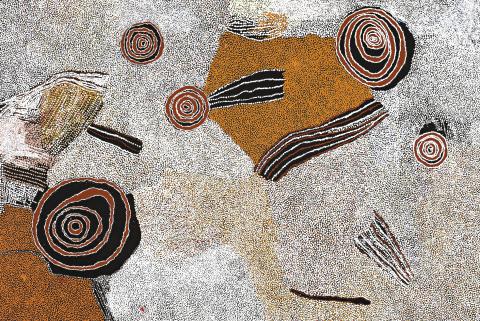ROCKHOLES AND COUNTRY NEAR THE OLGAS, 2007
BILL WHISKEY TJAPALTJARRI
synthetic polymer paint on linen
182.0 x 270.0 cm
inscribed verso: artist's name and Watiyawanu Artists of Amunturrungu cat. 10-07393
Watiyawanu Artists of Amunturrungu, Mount Liebig
Japingka Gallery, Fremantle
Private collection, Melbourne
In the space of a few intense years, Senior Watiyawanu artist, Bill Whiskey produced a small but significant body of paintings focused on the Pirupa Akla (Olgas) area – his birthplace in the early 1920s. As a young man, following the death of most of his family, he travelled with other community members to Haasts Bluff Mission where ‘they were scared of the white man and other goings on’. Moving on, they arrived at the Areyonga Community where they first ate ‘white man food’. Whiskey told stories of how they would throw the food behind their backs, because of the oddness of the taste.1 After a short time at Patapirri the travellers returned to Haasts Bluff Mission where they were ‘clothed’ for the first time. There Bill Whiskey met his wife Colleen Nampitjinpa. Later he moved to the outstation of Amunturrungu (Mount Liebig) where he lived with his wife and children before returning with family to Haasts Bluff. Both he and his wife were highly respected as traditional healers (ngangkan); in the morning he would report on what he had seen while travelling over the landscape during his dreams.
Though he had previously painted intricate dot designs on spears and small nulla nullas, he appeared in 2004 at the arts centre of the Watiyawanu Artists of the Amunturrungu Aboriginal Corporation and announced to the women that he wanted to do a painting. Over the years 2004 to 2008 he produced a body of work astounding in its shimmering vigour, pulsating colour and often monumental scale.
This work, created during the second last year of his opus, is a fine example of the epic scale he worked on. As the eye travels across the surface of the painting, it dissolves into a dynamic openness allowing the iconic indications of walking tracks, and key land forms pertaining to the ancestral white cockatoo story to hover. The forms circulate within a fluent, highly-sensitised space, radically distinct from the perspectival regimes characterizing Renaissance and post-Renaissance European landscape painting. The sheer profusion of dots is not employed as infill (as might be the case with lesser artists) but rather, sets up swirling, swarming optical rhythms that release and transmit the key narrative elements concerning the white cockatoo, the eagle and the crow so that the whole picture becomes charged. At the same time, these vibrating, resonating swathes of varied dotting, invoke the vast expanses of country, linking features such as the dazzling white rock of the cockatoo, the rockpools, the scattered shards of glistening white stone and other ‘tell-tale’ signs of the furious battle of ancestral birds that formed his country.
Bill Whiskey is one of the few artists of any persuasion for whom a very large canvas is not so much an indulgence as a passionate imperative. That he painted such a gigantic and yet so delicately and intimately composed canvas while in his eighties is testament to his exceptional fervour and integrity as both artist and traditional custodian. His power as a healer was also his power as a painter. It is perhaps because of the exceptional brevity of his artistic output that his unique achievement is yet to be adequately recognised.
1. Biographical details from certificate of authenticity
